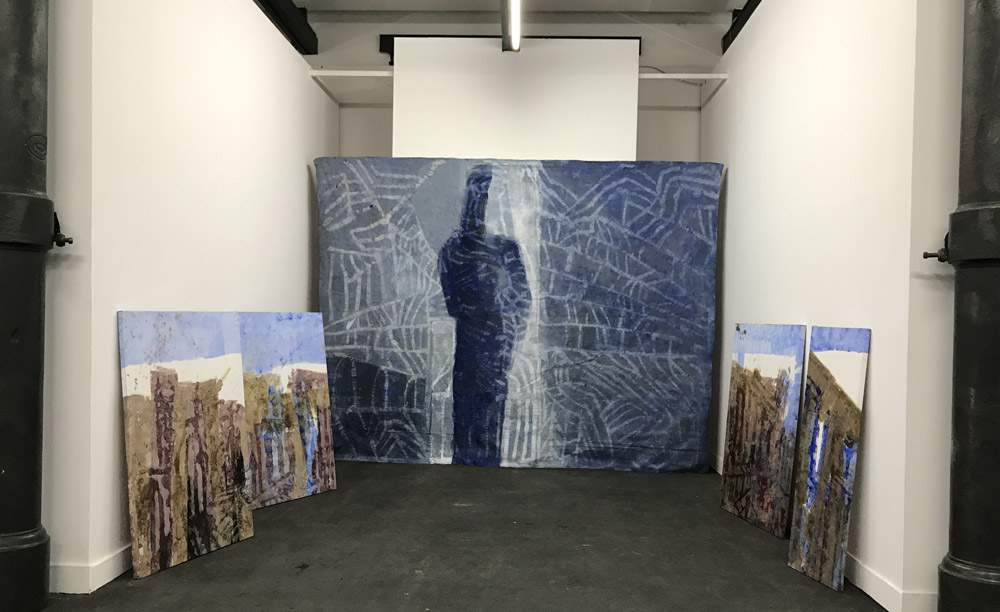Recovering beauty from Palmyra to Bamiyan: Franca Pisani's exhibition at MACRO in Rome
Entitled Archaeological Code. The Recovery of Beauty the solo exhibition of Franca Pisani (Grosseto, 1956) that opens Sept. 29 at MACRO Testaccio in Piazza Orazio Giustiniani in Rome (it will run until Nov. 26). Forty-seven works are on display: nine frescoes on Lyon silk, eight marbles on canvas, paintings, installations and ten remarkable teleri (the large canvases that in ancient Venice were placed to decorate the walls of buildings, in place of the frescoes that, due to the humidity of the lagoon, would soon be ruined: Carpaccio’s, Titian’s, Tintoretto’s, and Veronese’s famous ones) measuring four meters by three, which are intended to bear witness to the rediscovery of four important archaeological sites, namely Hatra, Nimrud, Bamiyan, and Palmyra, unfortunately badly scarred in recent years by the religious fundamentalism that so much damage has been done to these ancient cities so important to human history.
It is precisely the ten teleri the works by Franca Pisani that perhaps more than the others intend to pay homage to the four archaeological sites. An ancient art, that of the telero, which “allows today,” we read in the presentation of the exhibition, “both an investigation into tradition and a dramatic confrontation with the rules that the necessary expressive force imposes for these great objects of art. The result is a kind of enchantment that the Roman location makes more engaging.”
But there is more, too, starting with the four levels on which the exhibition is divided, each connected to the four cities: Nomad elder takes us to Bamiyan in Afghanistan, where there were two huge Buddhas carved into the rock that were destroyed by the Taliban on March 12, 2001. The second level, Nomad Wind, takes the visitor to Hatra, where Lamassu, sculptures depicting androcephalic bulls, that is, bulls with the heads of men, once stood. The third level, Nomad Adolescent, on the other hand, is connected to the ancient Assyrian city of Nimrud, while the last level, Nomad Curious, is intended to pay homage to the memory of the ancient city of Palmyra: the centerpiece of the section are The Stone Tree, an ash tree with an Apuan statuary marble cylinder inserted inside on which primordial signs have been carved, and two large canvases that evoke the ancient Roman amphitheater of the Syrian city. There will also be an additional fifth level, a female Nomad figure. An exhibition, curated by Duccio Trombadori, which therefore intends to evoke and pay homage to the beauty of four fundamental archaeological sites with dense works that are the result of specific research on the part of the artist, who was also already present at the Venice Biennale.
The exhibition is open to the public during the opening hours of MACRO Testaccio (Pavilion 9B), Tuesday through Sunday, from 2 to 8 p.m. (ticket office closes 30 minutes before). Tickets for MACRO Testaccio: €6 full price non-residents, €5 full price residents, €5 reduced price non-residents, €4 reduced price residents. Possibility of cumulative ticket MACRO Testaccio + MACRO via Nizza: €12.50 full non-residents, €11.50 full residents, €11.50 reduced non-residents, €10.50 reduced residents. The catalog, published by Maretti Editore, features essays by Duccio Trombadori and Cristina Acidini. The exhibition is promoted by Roma Capitale - Assessorato alla crescita culturale and the Sovrintendenza Capitolina ai Beni Culturali. All info at www.museomacro.org.
 |
| Recovering beauty from Palmyra to Bamiyan: Franca Pisani's exhibition at MACRO in Rome |
Warning: the translation into English of the original Italian article was created using automatic tools. We undertake to review all articles, but we do not guarantee the total absence of inaccuracies in the translation due to the program. You can find the original by clicking on the ITA button. If you find any mistake,please contact us.





























